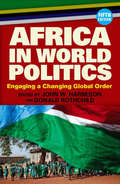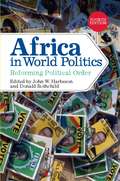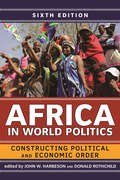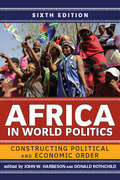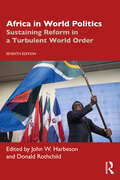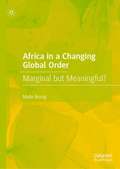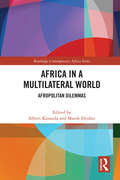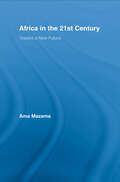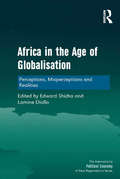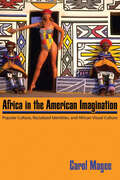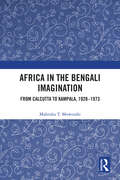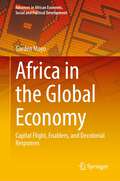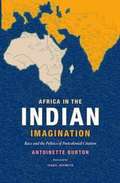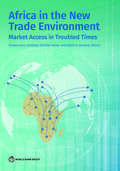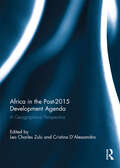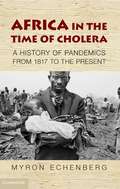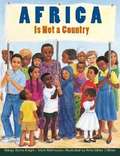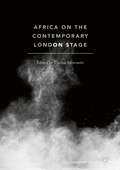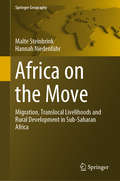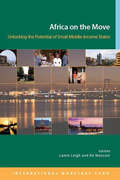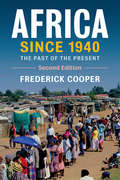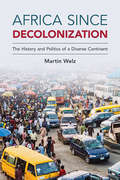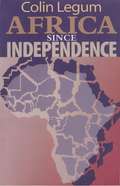- Table View
- List View
Africa in World Politics
by Donald Rothchild John W. HarbesonIn this fully revised edition top scholars in African politics address the effects that major currents in Africa and world politics have upon each other and explore the ramifications of this interconnection for contemporary theories of international and comparative politics. The fifth edition focuses on engaging a changing world order. The nation-state as we know it is a legacy of European rule in Africa, and the primacy of the nation-state remains the bedrock of most contemporary theories of international relations. Yet in the fifth decade of Africa’s independence, this colonial inheritance has been challenged as never before by state weakness, internal and inter-state conflict, new gains in economic development, large investments by China and other G-20 countries, and internal and external demands for economic and political reform, with potentially far-reaching implications. Including new readings on the Sudan, the Great Lakes crisis, and bilateral vs. multilateral peacekeeping on the continent, this text remains an invaluable resource for students of African and world politics.
Africa in World Politics
by HarbesonPolitical scientists and economists examine issues presented by the improvements in domestic economic and politics in sub-Saharan Africa and the emergence of the region onto the world stage. Among their topics are the heritage of colonialism, promising democratization trajectories in Africa's weak states, inter-African negotiations and reforming political order, and China's engagement in Africa. Annotation ©2008 Book News, Inc. , Portland, OR (booknews. com)
Africa in World Politics
by HarbesonIn this fully revised edition top scholars in African politics address the effects that major currents in Africa and world politics have upon each other and explore the ramifications of this interconnection for contemporary theories of international and comparative politics. The fourth edition focuses on issues of reforming and strengthening states and their economies in sub-Saharan Africa. The nation-state as we know it is a legacy of European rule in Africa, and the primacy of the nation-state remains a bedrock of most contemporary theories of international relations. Yet in the fifth decade of Africa's independence, this colonial inheritance has been challenged as never before by state weakness, internal and inter-state conflict, and internal and external demands for economic and political reform, with potentially far-reaching implications. Including new readings on the AIDS crisis in Africa and the regional war on terrorism, this text remains an invaluable resource for students of African and world politics.
Africa in World Politics: Constructing Political and Economic Order
by Donald Rothchild John W HarbesonThe sixth edition of Africa in World Politics focuses on challenges African states face in constructing viable political economies in contexts both of familiar domestic challenges and an unprecedented mix of engagements, opportunities, and threats emanating from a turbulent and rapidly changing international order. This text, including new chapters on Nigeria and the influence of party politics on economic development, remains an invaluable resource for students of African politics seeking to navigate the continent's complex political and economic landscapes. Revised chapters consider both the extent and the limits of continued healthy growth rates in many countries; the impacts of investments by China and other BRICS countries; plateaus and some reversals in progress on human rights and democratization; dimensions of chronic state weakness deepened by insurgencies, including some that are connected to Al Qaeda and the Islamic State; and peacebuilding efforts struggling to uphold responsible sovereignty in the Sudans, the Great Lakes region, and elsewhere.
Africa in World Politics: Constructing Political and Economic Order
by John W Harbeson,Donald RoThe sixth edition of Africa in World Politics focuses on challenges African states face in constructing viable political economies in contexts both of familiar domestic challenges and an unprecedented mix of engagements, opportunities, and threats emanating from a turbulent and rapidly changing international order. This text, including new chapters on Nigeria and the influence of party politics on economic development, remains an invaluable resource for students of African politics seeking to navigate the continent's complex political and economic landscapes. Revised chapters consider both the extent and the limits of continued healthy growth rates in many countries; the impacts of investments by China and other BRICS countries; plateaus and some reversals in progress on human rights and democratization; dimensions of chronic state weakness deepened by insurgencies, including some that are connected to Al Qaeda and the Islamic State; and peacebuilding efforts struggling to uphold responsible sovereignty in the Sudans, the Great Lakes region, and elsewhere.
Africa in World Politics: Sustaining Reform in a Turbulent World Order
by Donald Rothchild John W. HarbesonAfrica in World Politics provides advanced undergraduate and graduate students with the perfect introduction to the challenges faced by African states on an increasingly turbulent world stage. Africa in World Politics has long served as the go-to resource for students of African politics seeking to navigate the continent’s complex political and economic landscapes. Updated throughout, this new edition includes new chapters on the unprecedented challenges the continent faces from climate change and the fallout of the COVID-19 global pandemic. Adding to existing coverage of international diplomacy, peacebuilding, women in politics, and the building blocks of political economy, the book also includes expanded coverage of the role of China in Africa, and fresh perspectives on decolonization. Drawing together insights from some of the world’s leading scholars of African politics, this textbook is an essential read for advanced students of political science and African studies.
Africa in a Changing Global Order: Marginal but Meaningful?
by Malte BrosigThis book focuses on marginal actors in the global order. Such a perspective is often missing as global order analysis is often biased towards exploring large powerful actors and equating their relations with global order. Such an approach is not only dated but also analytically incomplete. It is because of the increasingly decentred nature of global order, that marginal actors and their relations, tactics, strategies and approaches matter for global order as they matter for these actors. The book starts by providing an analytical framework exploring different policy options for African agency which are located along a nexus of choices ranging from accommodation, engagement to system transformation. The selection of a particular interaction type is argued to be dependent on external opportunity structures in the form of different global orders reaching from competitive polarity to dispersed forms of authority or even non-polarity. In addition to these external conditions, the ability to generate meaningful African agency facilitates a greater role in global order. Empirically, the book covers four policy fields which are peace and security, international criminal justice, economics and trade and COVID-19.
Africa in a Multilateral World: Afropolitan Dilemmas (Routledge Contemporary Africa)
by Albert KasandaThe book analyses how Africans and Africa relate to other parts of the multilateral world, and to the world in general, and how these relations stem from local, national and regional interactions in different parts of Africa, as well as Africa as a whole. The first part focuses on the assumptions that are necessary to understand the role of Africa on the global stage, especially from the perspectives of political philosophy and global and international studies. The second part of the book looks at both Afropolitan trends and the limits of Afropolitanism. In the third part the authors focus on specific African global tendencies stemming from the local conditions in several case studies. Traditional and modern politics is connected, problematically, with the current Jihadist organisations in the local African conditions related to unilateralism and global war on terror, for example. The fourth part deals with the relevance of the language ambivalence in relation to global interactions. It examines various views of African philosophy and lays bare the perception of earlier colonial languages in view of their current strength of global action. This book will be of interest to scholars of African studies, political philosophy, politics and global studies.
Africa in the 21st Century: Toward a New Future (African Studies)
by Ama MazamaAfrica in the 21st Century: Toward a New Future brings together some of the finest Pan African and Afrocentric intellectuals to discuss the possibilities of a new future where the continent claims its own agency in response to the economic, social, political, and cultural problems which are found in every nation. The volume is structured around four sections: I. African Unity and Consciousness: Assets and Challenges; II. Language, Information, and Education; III. African Women, Children and Families; and IV. Political and Economic Future of the African World. In original essays, the authors raise the level of discourse around the questions of integration, pluralism, families, a federative state, and good governance. Each writer sees in the continent the potential for greatness and therefore articulates a theoretical and philosophical approach to Africa that constructs a victorious consciousness from hard concrete facts. This book will interest students and scholars of the history and politics of Africa as well as professional Africanists, Africologists, and international studies scholars who are inclined toward Africa.
Africa in the Age of Globalisation: Perceptions, Misperceptions and Realities (The International Political Economy of New Regionalisms Series)
by Edward Shizha Lamine DialloThis is a collection of bold and visionary scholarship that reveals an insightful exposition of re-visioning African development from African perspectives. It provides educators, policy makers, social workers, non-governmental agencies, and development agencies with an interdisciplinary conceptual base that can effectively guide them in planning and implementing programs for socio-economic development in Africa. The book provides up-to-date scholarly research on continental trends on various subjects and concerns of paramount importance to globalisation and development in Africa (politics, democracy, education, gender, technology, global relationships and the role of non-governmental organisations). The authors challenge the familiar paradigms in order to show how imperfectly, if at all, assumptions about globalisation and development theories have failed in their depictions and applications to Africa. The scholars in this volume both inform and advocate for a re-visioning of perceptions on Africa and how it navigates global processes.
Africa in the American Imagination: Popular Culture, Racialized Identities, and African Visual Culture
by Carol MageeIn the American world, the presence of African culture is sometimes fully embodied and sometimes leaves only a trace. Africa in the American Imagination: Popular Culture, Racialized Identities, and African Visual Culture explores this presence, examining Mattel's world of Barbie, the 1996 Sports Illustrated swimsuit issue, and Disney World, each of which repackages African visual culture for consumers. Because these cultural icons permeate American life, they represent the broader U.S. culture and its relationship to African culture. This study integrates approaches from art history and visual culture studies with those from culture, race, and popular culture studies to analyze this interchange. Two major threads weave throughout. One analyzes how the presentation of African visual culture in these popular culture forms conceptualizes Africa for the American public. The other investigates the way the uses of African visual culture focuses America's own self-awareness, particularly around black and white racialized identities. In exploring the multiple meanings that “Africa” has in American popular culture, Africa in the American Imagination argues that these cultural products embody multiple perspectives and speak to various sociopolitical contexts: the Cold War, civil rights, and contemporary eras of the United States; the apartheid and post-apartheid eras of South Africa; the colonial and postcolonial eras of Ghana; and the European era of African colonization.
Africa in the Bengali Imagination: From Calcutta to Kampala, 1928-1973
by Mahruba T. MowtushiThis book examines textual representations of Africa in the Indian imagination from 1928 to 1973. It critically analyses Bengali literature during this period, their imitation of colonial racial prejudices and how it allowed Bengalis to fashion their identity. It analyses the development of ‘Africa’ as an idea and historical reality through the writings of five Bengali writers including the Bengali novelist Bibhutibhushan Bandyopadhyay, the children’s author Hemendra Kumar Roy, the poet and philosopher Rabindranath Tagore, the playwright Ganesh Bagchi and the surrealist poet and founding editor of Transition magazine Rajat Neogy. The book shows how these writers engage with the idea of Africa and their influence in the construction of the Bengali cultural identity during the freedom struggle, the Partition of Bengal in 1947 and the creation of Bangladesh in 1971. The book offers readers a glimpse of the exotic imaginary locales of Africa while offering an in-depth look into the interconnected histories, cartographic routes and cultural exchange between India and Africa. A first of its kind, this book will be an excellent read for students and scholars of literature, comparative literature, history, cultural studies, postcolonial studies, South Asian studies, African studies and diaspora studies. .
Africa in the Global Economy: Capital Flight, Enablers, and Decolonial Responses (Advances in African Economic, Social and Political Development)
by Gorden MoyoThis book discusses the role played by powerful global institutions such as the IMF, the World Bank, the World Trade Organisation, multinational corporations, and the international credit rating agencies in keeping Africa marginalised in the world economy. The book focuses on the intrusive roles of these institutions as enablers and beneficiaries of capital outflows and financial subordination in Africa. Diverging from the official narrative that touts China and the other emerging economies as global reformers that are poised to partner Africa in its fight against financial subjugation, the book instead argues that, like the Western powers, the emerging economies are benefiting prodigiously from a rigged global financial system that keeps Africa as a net creditor to the rest of the world. The book draws its theoretical framework from the repressed heterodox theories including dependency, core-periphery, world systems and Marxist theories as well as the decolonial approach. It concludes with a call for a decolonial African agency that should champion an epistemic rebellion against the neo-liberal and neo-classic economic traditions that have been historically deployed to justify Africa’s subordinated position in the global economic governance. This book comes at moment in time when Africa is ready to become a Rule Maker not a Rule Taker. The analysis Dr. Moyo presents having been in the front line of public policy and international negotiations demonstrate the need for Africa to re-write the rules to foster our own Transformation. Jason Rosario Braganza, Executive Director, African Forum and Network on Debt and Development (AFRODAD)
Africa in the Indian Imagination: Race and the Politics of Postcolonial Citation
by Antoinette BurtonIn Africa in the Indian Imagination Antoinette Burton reframes our understanding of the postcolonial Afro-Asian solidarity that emerged from the 1955 Bandung conference. Afro-Asian solidarity is best understood, Burton contends, by using friction as a lens to expose the racial, class, gender, sexuality, caste, and political tensions throughout the postcolonial global South. Focusing on India's imagined relationship with Africa, Burton historicizes Africa's role in the emergence of a coherent postcolonial Indian identity. She shows how--despite Bandung's rhetoric of equality and brotherhood--Indian identity echoed colonial racial hierarchies in its subordination of Africans and blackness. Underscoring Indian anxiety over Africa and challenging the narratives and dearly held assumptions that presume a sentimentalized, nostalgic, and fraternal history of Afro-Asian solidarity, Burton demonstrates the continued need for anti-heroic, vexed, and fractious postcolonial critique.
Africa in the New Trade Environment: Market Access in Troubled Times
by Souleymane Coulibaly Woubet Kassa Albert G. ZeufackSub-Saharan Africa represents only a small share of global production and trade while hosting half of the extreme poor worldwide. To catch up with the rest of the world, the continent has no alternative: it must undertake reforms to scale up its supply capacity while better linking its production and trade to the global economy. If it does so, it stands to gain from unlimited demand and innovation along the supply chain. Some progress has been made over the past decade, with the region’s exports and imports growing rapidly. Because most African economies rely heavily on trade for a large share of national income, they will also be more vulnerable to the trade disruptions of external shocks, as illustrated by the recent COVID-19 pandemic. Africa in the New Trade Environment: Market Access in Troubled Times provides a comprehensive, state-of-the-art analysis by a team of renowned trade economists who present a strategy to bolster Sub-Saharan Africa’s market access in the current global environment. It explores three key areas: • The impact of trade agreements (unilateral, regional, and multilateral) with traditional partners (the US and the EU) and a suggested way forward • The role of new market frontiers in Asia from the perspectives of both restructuring African economies and the changes in global value chains and their implications for Africa • The promise and challenges of Africa’s own regional trade and regional value chains through a well-considered and well-implemented regional integration strategy. The book meticulously explores ways to maximize Africa’s access to the two leading world markets—the EU and the US—while also diversifying its access to the emerging Asian market. Finally, it calls for an anchoring of the continent’s market access strategy in deeper intraregional trade integration. The world’s largest free trade project—the African Continental Free Trade Area—presents a major opportunity for the region’s large, resource-rich, middle-income countries to lead African firms into stronger regional and global value chain participation.
Africa in the Post-2015 Development Agenda: A Geographical Perspective
by Leo Charles Zulu and Cristina D’AlessandroThis book offers a multifaceted examination of Africa’s development into the post-2015 global agenda from a geographical perspective. As a diversified and highly applied discipline, geography has a lot to offer to global debates, nuanced analysis of problems on and the search for innovative solutions to advance the African development agenda beyond 2015. The end of the Millennium Development Goals (MDGs) era and the launch of the Sustainable Development Goals (SDGs) in September 2015 mark an important turning point for Africa and an opportune time to examine new challenges and opportunities that it faces. The regional disparities in MDG progress affirm an important geographic tenet that the unique yet internally differentiated socio-cultural, economic, political, ecological, biophysical and historical context give Africa distinctive challenges and opportunities that demand particular approaches to development. This edited book presents innovative contributions examining Africa’s development performance in diverse sectors during the MDG era as a basis for understanding prospects for its development in the SDG era and beyond. It offers new and innovative study perspectives and methodological approaches on urban transformation, development financing, food security, climate change, gender equality, health, and regional integration, among other topics, and useful insights for scholars, students and development practitioners. This book was originally published as a special issue of African Geographical Review, the journal of the American Association of Geographers’ Africa Specialty Group, to mark the transition from MDGs to SDGs.
Africa in the Time of Cholera
by Myron EchenbergThis book combines evidence from natural and social sciences to examine the impact on Africa of seven cholera pandemics since 1817, particularly the current impact of cholera on such major countries as Senegal, Angola, Mozambique, Congo, Zimbabwe and South Africa. Myron Echenberg highlights the irony that this once-terrible scourge, having receded from most of the globe, now kills thousands of Africans annually - Africa now accounts for more than 90 percent of the world's cases and deaths - and leaves many more with severe developmental impairment. Responsibility for the suffering caused is shared by Western lending and health institutions and by often venal and incompetent African leadership. If the threat of this old scourge is addressed with more urgency, great progress in the public health of Africans can be achieved.
Africa in the World: Capitalism, Empire, Nation-State
by Frederick CooperAt the Second World War's end, it was clear that business as usual in colonized Africa would not resume. W. E. B. Du Bois's The World and Africa, published in 1946, recognized the depth of the crisis that the war had brought to Europe, and hence to Europe's domination over much of the globe. Du Bois believed that Africa's past provided lessons for its future, for international statecraft, and for humanity's mastery of social relations and commerce. Frederick Cooper revisits a history in which Africans were both empire-builders and the objects of colonization, and participants in the events that gave rise to global capitalism. Of the many pathways out of empire that African leaders envisioned in the 1940s and 1950s, Cooper asks why they ultimately followed the one that led to the nation-state, a political form whose limitations and dangers were recognized by influential Africans at the time. Cooper takes account of the central fact of Africa's situation--extreme inequality between Africa and the western world, and extreme inequality within African societies--and considers the implications of this past trajectory for the future. Reflecting on the vast body of research on Africa since Du Bois's time, Cooper corrects outdated perceptions of a continent often relegated to the margins of world history and integrates its experience into the mainstream of global affairs.
Africa is Not a Country
by Anne Sibley O'BrienEnter into the daily life of children in the many countries of modern Africa. Countering stereotypes, Africa Is Not a Country celebrates the extraordinary diversity of this vibrant continent as experienced by children at home, at school, at work, and at play.
Africa on the Contemporary London Stage
by Tiziana MorosettiThis collection of essays investigates the way Africa has been portrayed on the London stage from the 1950s to the present. It focuses on whether — and, if so, to what extent — the Africa that emerges from the London scene is subject to stereotype, and/or in which ways the reception of audiences and critics have contributed to an understanding of the continent and its arts. The collection, divided into two parts, brings together well-established academics and emerging scholars, as well as playwrights, directors and performers currently active in London. With a focus on Wole Soyinka, Athol Fugard, Bola Agbaje, Biyi Bandele, and Dipo Agboluaje, amongst others, the volume examines the work of key companies such as Tiata Fahodzi and Talawa, as well as newer companies Two Gents, Iroko Theatre and Spora Stories. Interviews with Rotimi Babatunde, Ade Solanke and Dipo Agboluaje on the contemporary London scene are also included.
Africa on the Move: Migration, Translocal Livelihoods and Rural Development in Sub-Saharan Africa (Springer Geography)
by Malte Steinbrink Hannah NiedenführThis book discusses migration and space-spanning social network relationships as normal realities of life in African societies. It offers an overview of the research landscape and introduces an agency-centered theoretical model that provides a conceptual framework for translocality. The authors Malte Steinbrink and Hannah Niedenführ plead for a translocal approach to social transformation, showing how the translocality of livelihoods is shaping the lives of half a billion people on the continent and impacting local conditions. Using an action-oriented approach, the book analyzes the effects of translocal livelihoods on diverse aspects of economic, environmental and social change in rural Sub-Saharan Africa. The study thus makes an innovative contribution not only to migration research and development studies but also to the discussion around the policy and practice of development cooperation and planning. It is time to rethink development in light of translocal realities. The book appeals to scholars and researchers in geography, sociology, policy-making and planning, development studies, migration research and rural development.
Africa on the Move: Unlocking the Potential of Small Middle-Income States
by Lamin Leigh Ali MansoorThis publicationd escribes the reforms needed to move small middle-income countries in sub-Saharan Africa to advanced-economy status. The result of intense discussions with public officials in the countries covered, the book blends rigorous theory, econometrics, and practitioners' insights to come up with practical recommendations for policymakers. It spans topics from macroeconomic vulnerability and reserve adequacy to labor market institutions and financial inclusion. The publicaiton is a must-read for researchers interested in the economic issues facing developing countries in sub-Saharan Africa.
Africa since 1940: The Past of the Present (New Approaches to African History #13)
by Frederick CooperAfrica since 1940 is the flagship textbook in Cambridge University Press' New Approaches to African History series. Now revised to include the history and scholarship of Africa since the turn of the millennium, this important book continues to help students understand the process out of which Africa's position in the world has emerged. A history of decolonisation and independence, it allows readers to see just what political independence did and did not signify, and how men and women, peasants and workers, religious and local leaders sought to refashion the way they lived, worked and interacted with each other. Covering the transformation of Africa from a continent marked by colonisation to one of independent states, Frederick Cooper follows the 'development question' across time, seeing how first colonial regimes and then African elites sought to transform African society in their own ways. He shows how people in cities and villages tried to make their way in an unequal world, through times of hope, despair, renewed possibilities, and continued uncertainties. Looking beyond the debate over what or who may be to blame, Cooper explores alternatives for the future.
Africa since Decolonization: The History and Politics of a Diverse Continent
by Martin WelzHome to more than 1.2 billion people, living in 54 recognized states, speaking around 3,000 languages, Africa is a diverse and complex continent made up of states which differ in regard to their colonial history, political system, socio-economic development, economic polices and their experience with crises and conflicts. This introduction and overview of African history and politics since decolonization emphasises throughout, the diversity of the continent. Organised thematically to include chapters on decolonization and its legacies, external influences, economics, political systems, inter-African relations, crises, conflicts and conflict management, and Africa's external relations, Martin Welz strikes a fine balance between the use of contextual information, analysis, case studies and examples with theoretical debates in development, politics and global policy. Accessible to students at all levels, it counters histories which offer reductive explanations of complex issues, and offers new insights into the role African actors have played in influencing international affairs beyond the continent.
Africa since Independence
by Colin LegumActivist, scholar, and political journalist Colin Legum assesses Africa's experience since independence and offers judicious predictions about the continent's future. Covering 50 years of sweeping change, this provocative and insightful book examines Africa's struggle for democracy, mounting economic problems, and AIDS.
